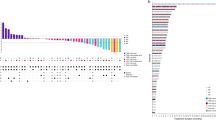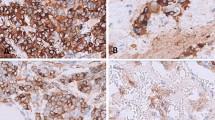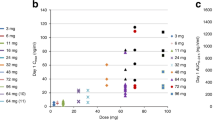Abstract
The growth inhibitory effects of cisplatin and etoposide on neuroblastoma cell lines were investigated in several scheduled combinations. Results were analyzed using median effect and combination index analyses. In all schedules in which cisplatin was administered prior to etoposide a synergistic effect was observed. Conversely, an antagonistic effect was seen in all schedules where etoposide was administered before cisplatin.
Similar content being viewed by others
Main
The design of the widely used OPEC protocol (oncovins, platinum agents, epipodophyllotoxins and cyclophosphamide) for management of the paediatric solid tumour neuroblastoma was based on clinical and in vitro evaluations of sequentially scheduled cisplatin and the epipodophyllotoxin, teniposide. These studies indicated that, for optimal anti-tumour effect, cisplatin should be administered prior to the epipodophyllotoxin (Hayes et al, 1981; Shafford et al, 1984; Pritchard et al, 1985).
In several more recent clinical protocols for neuroblastoma, this apparently optimal order of drug administration has not been retained. The order of administration has been reversed in some regimens (Gordon et al, 1992; Tweddle et al, 2001) or the drugs are administered concurrently (reviewed in Pinkerton et al, 2000). If the OPEC rationale was correct, this altered scheduling pattern could result in sub-optimal response. Furthermore, in many of these schedules, cisplatin has been replaced by carboplatin. This will accentuate the change in order of administration because, despite the fact that carboplatin forms essentially the same final DNA adducts as cisplatin, the cytotoxic cross-linked structures develop more slowly than with cisplatin (Knox et al, 1986).
The present study was aimed at determining, using contemporary methods of analysis, whether the currently used epipodophyllotoxin, etoposide, in combination with cisplatin, caused effects on neuroblastoma cell lines that were dependent upon the relative timings of the drug exposures.
Materials and methods
Cell culture and drug solutions
The neuroblastoma cell lines SHSY5Y (Ciccarone et al, 1989) and NGP (Brodeur et al, 1977) were kindly provided by Drs P Lovat and D Tweddle (University of Newcastle upon Tyne). Cells were grown in RPMI 1640 (Dutch modification, supplemented with 10% v/v foetal bovine serum, and antibiotics (Gibco BRL)) at 37°C/5% CO2. Frequent tests for mycoplasma infection were always negative. Etoposide was dissolved in methanol and stored at −20°C. Cisplatin was freshly dissolved in DMSO just prior to each experiment and immediately diluted into medium. During drug exposures, the concentrations of methanol and DMSO were kept below 1% and 0.001% respectively in treated and control wells.
Sulphorhodamine B (SRB) assay
For each experiment, cells were inoculated into three 96-well tissue culture plates and incubated for 24 h prior to starting drug exposures (time zero). Plates were exposed to graded concentrations of either: the first drug in the schedule only followed by the diluent for the second drug; the diluent for the first drug in the schedule followed by the second drug in the schedule; or both drugs in the schedule according to the schedule design. The plates were washed twice in drug free medium in between each drug/diluent exposure. After the final wash plates were returned to the incubator for 5 days. Procedures for fixing, staining and reading (OD570) were carried out as described by Skehan et al (1990).
Median effect and combination index analysis
Drug interactions were analyzed using CalcuSyn (Chou and Hayball, 1996). This software calculates the median effect dose, Dm (analogous to the IC50), of the drug combinations using the median effect equation. Determination of synergy or antagonism was based on the multiple drug effect equation of Chou and Talalay (1977, 1983) and was quantified by the combination index (CI). CI=1 indicates an additive effect; <1, synergy, >1, antagonism. Results are shown for the mutually exclusive assumption of modes of activity of the drugs, however, applying the alternative assumption showed the same pattern of results.
Results
Response of neuroblastoma cell lines to single agents
A prerequisite for evaluating the effect of drug combinations on cells is the determination of the effects of each agent acting alone within the schedule, retaining the exact timings of drug exposure as in the combined treatments. Effects of single agents were measured under four different schedules, which paralleled the more complex conditions of the combination experiments.
The responses of SHSY5Y cells exposed to etoposide were affected by the interval between seeding and drug exposure as is illustrated by the Dm values in Table 1. Sensitivity of the cells exposed to etoposide for 4 or 24 h periods, decreased with an increase in the interval between seeding and drug exposure.
Sensitivity of NGP cells to etoposide was not dependent on the time interval between seeding and drug exposure and was approximately 5–10-fold greater than the SHSY5Y cells (Table 1).
The responses of SHSY5Y and NGP cells to cisplatin, were independent of the time interval between seeding and drug exposure (Table 1). NGP cells were slightly more sensitive to cisplatin than SHSY5Y cells (Table 1).
Response of SHSY5Y cells to combinations of etoposide and cisplatin
Figure 1 shows the dose response curves for SHSY5Y cells in each of seven schedules and Figure 2 shows the mean combination index (CI) values plotted against fraction of cells affected. Figure 1C, D and E represent the results obtained when each drug was present for 24 h, either one immediately before the other or concurrently. There was little difference between the dose-response curves or Dm values for these schedules (Figure 1 and Table 2). However, the Dm values alone do not take into account the effect of the timing upon etoposide sensitivity in relation to seeding of the cells. As reported above, cells exposed to etoposide at time zero were approximately two-fold more sensitive than cells exposed 24 h later (Table 1). Combination index analysis based on single drug controls, takes this effect into account (Figure 2 and Table 2). Comparison of C, D and E in Figure 2 show a trend for the CI values to increase as the order of drug exposure changes from cisplatin first, to simultaneous exposure, to cisplatin last. For schedule C, most CI values were less than one, indicating a slight degree of synergy, while for schedule E, most values were greater than one, indicating antagonism.
Dose response curves for SHSY5Y cells exposed to scheduled exposures of cisplatin and etoposide. For each schedule, curves are shown for both drugs as single agents administered at appropriate time points together with the drug combination. Cells were seeded in 96-well plates and allowed to adhere for 24 h (time 0). Cells were exposed to either a mixture of cisplatin and etoposide for 24 h (D), or, cisplatin for 24 h (A, C, F), washed and further exposed to 4 h of etoposide (A), 24 h etoposide (C) or drug free medium for 24 h followed by 4 h of etoposide (F). Panels B, E and G show the reverse of schedules shown in A, C, and F respectively. The mean of at least three experiments are shown and error bars represent standard deviations (s.d.) from the mean. For schematics at the top of each panel, black rectangles represent cisplatin exposures, white rectangles represent etoposide exposures.
Combination index plots for SHSY5Y cells exposed to scheduled exposures of cisplatin and etoposide. Combination index plots were generated by the computer software CalcuSyn® for each of at least three experiments for each schedule. The data points in each panel represent the means of the generated plots and error bars represent the standard deviations. The equation for calculation of the combination index for two drugs (1 and 2) with mutually exclusive modes of action at the median effect dose is also shown. For schematics at the top of each panel, black rectangles represent cisplatin exposures, white rectangles represent etoposide exposures.
In experiments aimed at more closely representing the clinical schedules of OPEC and OJEC, cisplatin exposure was for 24 h while etoposide was added for 4 h. When the drug exposures followed each other immediately, combination index values were slightly lower when cisplatin preceded etoposide (Figure 2A,B). When a 24 h period occurred between the same drug exposures, cisplatin before etoposide (schedule F), resulted in a lower degree of inhibition and higher Dm values (Table 2) compared to the opposite order (Figure 1F,G). This was the predicted result based on the difference in potency between etoposide administered at zero time and at 48 h after zero time (approximately four-fold; Table 1). However, the CI values were consistently less than 1 when exposure to cisplatin was first (Figure 2F,G), indicating that the synergistic effect of this drug sequence was enough to overcome the increased potency of etoposide when it was added at zero time.
Overall, the data in Figure 2 show that, changing schedules from cisplatin first (left-hand panels) to cisplatin last (right-hand panels) resulted in increased CI values. This indicates a consistent change from synergy to antagonism when the etoposide exposure was changed from after to before cisplatin.
Response of NGP cells to combinations of etoposide and cisplatin
For NGP cells, the schedule in which cisplatin was administered for 24 h prior to etoposide for 24 h required significantly lower doses to achieve 50% inhibition of growth than did the reverse schedule (Table 2).
The combination index analyses confirmed the difference between the Dm values for these schedules (Figure 3). For schedule C, in which cisplatin was administered prior to etoposide, the majority of the CI values were less than 1, indicating synergy (Figure 3A). Conversely, for schedule E, the majority of the values were greater than 1, indicating antagonism (Figure 3B). Therefore, cisplatin prior to etoposide produced the greatest growth inhibitory effect upon NGP cells.
Combination index plots for NGP cells exposed to scheduled exposures of etoposide and cisplatin. The computer software CalcuSyn® simulates combination index curves to fit experimental values. For each schedule, the mean and standard errors are shown for at least three replicate experiments. The dotted line at CI=1 represents additivity. Values above this line indicate antagonism, below this line indicates synergy. (A) Sequential exposure to cisplatin followed by etoposide each for 24 h (Schedule C). (B) the reverse of A. (Schedule E).
Discussion
Scheduling patterns in which cells were exposed to both drugs, each for 24 h were shown to result in a synergistic response in both SHSY5Y cells and NGP cells when cisplatin was administered prior to etoposide. SHSY5Y cells also exhibited this response when the exposure time to etoposide was reduced to 4 h (NGP cells were not tested with this schedule). Introducing a 24 h drug-free period between drug exposures gave a similar pattern of combination indexes to the other schedules. Overall, the results showed that changing schedules from cisplatin first to cisplatin last resulted in a change from synergy to antagonism. The exact degrees of synergy/antagonism are probably dependent upon both the model underlying the analysis method and the techniques used to measure cytotoxicity.
In the recently developed OJEC protocol for neuroblastoma therapy, carboplatin is administered for 1 h immediately following a 4 h etoposide infusion (Tweddle et al, 2001), allowing day-care chemotherapy. This is a reversal of the OPEC protocol in which cisplatin is infused for 24 h, followed by 24 h post-hydration and finally 4 h of etoposide. Replacement of cisplatin by carboplatin also reduces toxic side-effects. Cisplatin and carboplatin form essentially the same DNA-adduct structures (Knox et al, 1986), however, carboplatin monofunctional adducts are converted to bifunctional adducts much more slowly than those formed with cisplatin (Knox et al, 1986; Peng et al, 1997), further complicating analysis of synergy. This slow formation of the toxic products with carboplatin will tend to enhance the antagonistic effects of administration of the platinum agent after etoposide.
Etoposide acts via the stabilization of topoisomerase II (topo II) cleavable complexes. This effect is reversible and furthermore etoposide has a short elimination half-life (Hsiang and Liu, 1989; Slevin, 1991; Caldecott et al, 1993; Willmore et al, 1998). Together with the slow formation of carboplatin-DNA adducts, the swift reversal of etoposide stabilised topo II cleavable complexes may result in reduced anti-tumour effect in patients.
In conclusion, if the results of this study are reflected by the action of drugs in the patient, then the adoption of schedules in which platinum agent follows etoposide and in which formation of platinum-DNA cross-links is delayed (carboplatin as opposed to cisplatin) may result in sub-optimal anticancer action. An understanding of the underlying mechanisms of interaction may help assessment of the clinical relevance of these effects.
Change history
16 November 2011
This paper was modified 12 months after initial publication to switch to Creative Commons licence terms, as noted at publication
References
Brodeur GM, Sekhon G & Goldstein MN (1977) Chromosomal aberrations in human neuroblastomas. Cancer 40: 2256–2263
Caldecott K, Banks G & Jeggo P (1993) The induction and reversal of topoisomerase II cleavable complexes formed by nuclear extract from the CHO DNA repair mutant, xrs1. Mutat Res 293: 259–267
Chou T & Hayball MP (1996) CalcuSyn, Windows software for dose effect analysis Cambridge: Biosoft
Chou T & Talalay P (1977) A simple generalized equation for the analysis of multiple inhibitions of Michaelis-Menten kinetic systems. J Biol Chem 252: 6438–6442
Chou T & Talalay P (1983) Analysis of combined drug effects: a new look at a very old problem. TIPS 4: 450–454
Ciccarone V, Spengler BA, Meyers MB, Biedler JL & Ross RA (1989) Phenotypic diversification in human neuroblastoma cells: expression of distinct neural crest lineages. Cancer Res 49: 219–225
Gordon SJ, Pearson AD, Reid MM & Craft AW (1992) Toxicity of single-day high-dose vincristine, melphalan, etoposide and carboplatin consolidation with autologous bone marrow rescue in advanced neuroblastoma. Eur J Cancer 28A: 1319–1323
Hayes FA, Green AA, Casper J, Cornet J & Evans WE (1981) Clinical evaluation of sequentially scheduled cisplatin and VM26 in neuroblastoma. Cancer 48: 1715–1718
Hsiang YH & Liu LF (1989) Evidence for the reversibility of cellular DNA lesion induced by mammalian topoisomerase II poisons. J Biol Chem 264: 9713–9715
Knox R, Friedlos F, Lydall DA & Roberts JJ (1986) Mechanism of cytotoxicity of anticancer platinum drugs: evidence that cis-diamminedichloro platinum(II) and cis-diammine-(1,1-cyclobutanedicarboxylato)platinum (II) differ only in the kinetics of their interaction with DNA. Cancer Res 46: 1972–1979
Peng B, Tilby MJ, English MW, Price L, Pearson AD, Boddy AV & Newell DR (1997) Platinum-DNA adduct formation in leucocytes of children in relation to pharmacokinetics after cisplatin and carboplatin therapy. Br J Cancer 76: 1466–1473
Pinkerton CR, Blanc Vincent MP, Bergeron C, Fervers B & Philip T (2000) Induction chemotherapy in metastatic neuroblastoma – does dose influence response? A critical review of published data standards, options and recommendations (SOR) project of the national federation of French cancer centres (FNCLCC). Eur J Cancer 36: 1808–1815
Pritchard J, Whelan R & Hill BT (1985) Sequential cis-platinum and VM26 in neuroblastoma: laboratory and clinical (OPEC regimen) studies. Prog Clin Biol Research 175: 545–555
Shafford EA, Rogers DW & Pritchard J (1984) Advanced neuroblastoma: Improved response rate using a multiagent regimen (OPEC) including sequential cisplatin and VM-26. J Clin Oncol 2: 742–747
Skehan P, Storeng R, Scudiero D, Monks A, McMahon J, Vistica D, Warren JT, Bokesch H, Kenney S & Boyd MR (1990) New colorimetric cytotoxicity assay for anticancer-drug screening. J Natl Cancer Inst 82: 1107–1112
Slevin ML (1991) The clinical pharmacology of etoposide. Cancer 67: 319–329
Tweddle DA, Pinkerton CA, Lewis IJ, Ellershaw C, Cole M & Pearson ADJ (2001) OPEC/OJEC for stage 4 neuroblastoma in children over 1 year of age. Med Pediatr Oncol 36: 239–242
Willmore E, Frank AJ, Padget K, Tilby MJ & Austin CA (1998) Etoposide targets topoisomerase IIalpha and IIbeta in leukemic cells: isoform-specific cleavable complexes visualized and quantified in situ by a novel immunofluorescence technique. Mol Pharmacol 54: 78–85
Acknowledgements
This work was supported by The Newcastle University Hospital Special Trustees and the North of England Children's Cancer Research Fund.
Author information
Authors and Affiliations
Corresponding author
Rights and permissions
From twelve months after its original publication, this work is licensed under the Creative Commons Attribution-NonCommercial-Share Alike 3.0 Unported License. To view a copy of this license, visit http://creativecommons.org/licenses/by-nc-sa/3.0/
About this article
Cite this article
Meczes, E., Pearson, A., Austin, C. et al. Schedule-dependent response of neuroblastoma cell lines to combinations of etoposide and cisplatin. Br J Cancer 86, 485–489 (2002). https://doi.org/10.1038/sj.bjc.6600060
Received:
Revised:
Accepted:
Published:
Issue Date:
DOI: https://doi.org/10.1038/sj.bjc.6600060






